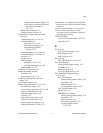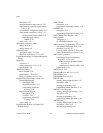
Index
AT-MIO-16X User Manual I-18
©
National Instruments Corporation
RTSI latch, 3-19
RTSI switch
definition, 3-30
programming, 5-39 to 5-43
control pattern (figure), 5-40
DMA operations, 5-41 to 5-42
interrupts, 5-43
selecting internal update counter, 5-32
signal connections
description, 3-30
programming considerations,
5-37 to 5-39
signals (table), 5-38
RTSI Switch Register Group, 4-71 to 4-73
register map, 4-2
RTSI Switch Shift Register, 4-72
RTSI Switch Strobe Register, 4-73
RTSICLK signal, 3-30
RTSITRIG bit, 4-8
S
S2 through S0 bits, 5-40
sample counters, programming, 5-17 to 5-20
sample counts 2 through 65,536, 5-18
sample counts greater than 65,536,
5-18 to 5-20
sample-interval counter, programming,
5-16 to 5-17
sample-interval timer, 3-9
scan interval, 5-10
scan interval counter, programming,
5-20 to 5-21
scan sequence, 5-10
SCANCLK signal
description (table), 2-18, B-5
multiple-channel data
acquisition, 3-12, 3-13
timing connections, 2-33
timing I/O circuitry, 3-29
SCANDIV bit
description, 4-6
programming multiple-analog input
channel configurations, 5-15
SCANEN bit
continuous channel scanning data
acquisition, 5-11
description, 4-7
interval-channel scanning data
acquisition, 5-14
SCLK bit, 4-5 to 4-6
SCN2 bit
description, 4-7
interval-channel scanning data
acquisition, 5-14
SDATA bit, 4-5
signal connections
analog input, 2-19 to 2-20
analog input configurations
common-mode signal rejection, 2-29
differential connections
DIFF input configuration, 2-22
floating signal sources,
2-24 to 2-26
ground-referenced signal
sources, 2-23
nonreferenced signal sources,
2-24 to 2-26
input modes, 2-7 to 2-11
available modes (table), 2-8
DIFF input, 2-8
NRSE input, 2-9 to 2-10
RSE input, 2-9
recommended configuration
(table), 2-22
single-ended connections,
2-26 to 2-27
floating signal sources (RSE
configuration), 2-27
grounded signal sources (NRSE
configuration), 2-28


















